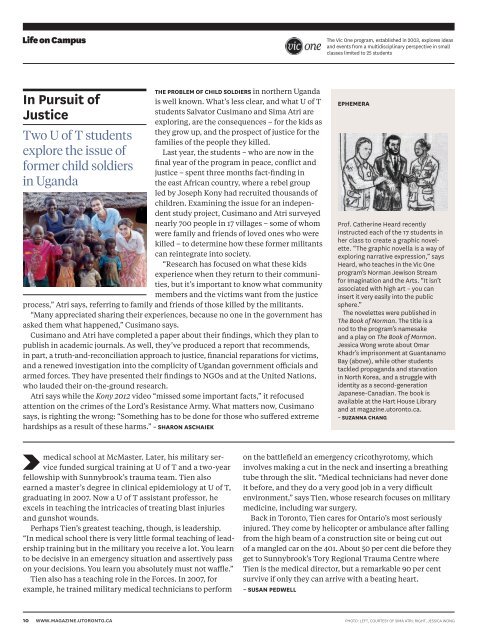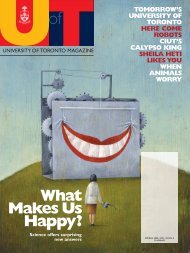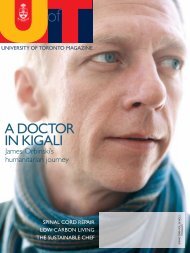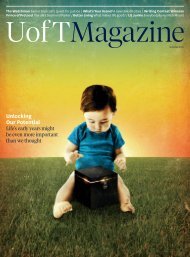What's the solution to Toronto's traffic problems? - University of ...
What's the solution to Toronto's traffic problems? - University of ...
What's the solution to Toronto's traffic problems? - University of ...
Create successful ePaper yourself
Turn your PDF publications into a flip-book with our unique Google optimized e-Paper software.
Life on Campus<br />
The Vic One program, established in 2003, explores ideas<br />
and events from a multidisciplinary perspective in small<br />
classes limited <strong>to</strong> 25 students<br />
In Pursuit <strong>of</strong><br />
Justice<br />
Two U <strong>of</strong> T students<br />
explore <strong>the</strong> issue <strong>of</strong><br />
former child soldiers<br />
in Uganda<br />
THE PROBLEM OF CHILD SOLDIERS in nor<strong>the</strong>rn Uganda<br />
is well known. What’s less clear, and what U <strong>of</strong> T<br />
students Salva<strong>to</strong>r Cusimano and Sima Atri are<br />
exploring, are <strong>the</strong> consequences – for <strong>the</strong> kids as<br />
<strong>the</strong>y grow up, and <strong>the</strong> prospect <strong>of</strong> justice for <strong>the</strong><br />
families <strong>of</strong> <strong>the</strong> people <strong>the</strong>y killed.<br />
Last year, <strong>the</strong> students – who are now in <strong>the</strong><br />
final year <strong>of</strong> <strong>the</strong> program in peace, conflict and<br />
justice – spent three months fact-finding in<br />
<strong>the</strong> east African country, where a rebel group<br />
led by Joseph Kony had recruited thousands <strong>of</strong><br />
children. Examining <strong>the</strong> issue for an independent<br />
study project, Cusimano and Atri surveyed<br />
nearly 700 people in 17 villages – some <strong>of</strong> whom<br />
were family and friends <strong>of</strong> loved ones who were<br />
killed – <strong>to</strong> determine how <strong>the</strong>se former militants<br />
can reintegrate in<strong>to</strong> society.<br />
“Research has focused on what <strong>the</strong>se kids<br />
experience when <strong>the</strong>y return <strong>to</strong> <strong>the</strong>ir communities,<br />
but it’s important <strong>to</strong> know what community<br />
members and <strong>the</strong> victims want from <strong>the</strong> justice<br />
process,” Atri says, referring <strong>to</strong> family and friends <strong>of</strong> those killed by <strong>the</strong> militants.<br />
“Many appreciated sharing <strong>the</strong>ir experiences, because no one in <strong>the</strong> government has<br />
asked <strong>the</strong>m what happened,” Cusimano says.<br />
Cusimano and Atri have completed a paper about <strong>the</strong>ir findings, which <strong>the</strong>y plan <strong>to</strong><br />
publish in academic journals. As well, <strong>the</strong>y’ve produced a report that recommends,<br />
in part, a truth-and-reconciliation approach <strong>to</strong> justice, financial reparations for victims,<br />
and a renewed investigation in<strong>to</strong> <strong>the</strong> complicity <strong>of</strong> Ugandan government <strong>of</strong>ficials and<br />
armed forces. They have presented <strong>the</strong>ir findings <strong>to</strong> NGOs and at <strong>the</strong> United Nations,<br />
who lauded <strong>the</strong>ir on-<strong>the</strong>-ground research.<br />
Atri says while <strong>the</strong> Kony 2012 video “missed some important facts,” it refocused<br />
attention on <strong>the</strong> crimes <strong>of</strong> <strong>the</strong> Lord’s Resistance Army. What matters now, Cusimano<br />
says, is righting <strong>the</strong> wrong: “Something has <strong>to</strong> be done for those who suffered extreme<br />
hardships as a result <strong>of</strong> <strong>the</strong>se harms.” – SHARON ASCHAIEK<br />
EPHEMERA<br />
Pr<strong>of</strong>. Ca<strong>the</strong>rine Heard recently<br />
instructed each <strong>of</strong> <strong>the</strong> 17 students in<br />
her class <strong>to</strong> create a graphic novelette.<br />
“The graphic novella is a way <strong>of</strong><br />
exploring narrative expression,” says<br />
Heard, who teaches in <strong>the</strong> Vic One<br />
program’s Norman Jewison Stream<br />
for Imagination and <strong>the</strong> Arts. “It isn’t<br />
associated with high art – you can<br />
insert it very easily in<strong>to</strong> <strong>the</strong> public<br />
sphere.”<br />
The novelettes were published in<br />
The Book <strong>of</strong> Norman. The title is a<br />
nod <strong>to</strong> <strong>the</strong> program’s namesake<br />
and a play on The Book <strong>of</strong> Mormon.<br />
Jessica Wong wrote about Omar<br />
Khadr’s imprisonment at Guantanamo<br />
Bay (above), while o<strong>the</strong>r students<br />
tackled propaganda and starvation<br />
in North Korea, and a struggle with<br />
identity as a second-generation<br />
Japanese-Canadian. The book is<br />
available at <strong>the</strong> Hart House Library<br />
and at magazine.u<strong>to</strong>ron<strong>to</strong>.ca.<br />
– SUZANNA CHANG<br />
medical school at McMaster. Later, his military service<br />
funded surgical training at U <strong>of</strong> T and a two-year<br />
fellowship with Sunnybrook’s trauma team. Tien also<br />
earned a master’s degree in clinical epidemiology at U <strong>of</strong> T,<br />
graduating in 2007. Now a U <strong>of</strong> T assistant pr<strong>of</strong>essor, he<br />
excels in teaching <strong>the</strong> intricacies <strong>of</strong> treating blast injuries<br />
and gunshot wounds.<br />
Perhaps Tien’s greatest teaching, though, is leadership.<br />
“In medical school <strong>the</strong>re is very little formal teaching <strong>of</strong> leadership<br />
training but in <strong>the</strong> military you receive a lot. You learn<br />
<strong>to</strong> be decisive in an emergency situation and assertively pass<br />
on your decisions. You learn you absolutely must not waffle.”<br />
Tien also has a teaching role in <strong>the</strong> Forces. In 2007, for<br />
example, he trained military medical technicians <strong>to</strong> perform<br />
on <strong>the</strong> battlefield an emergency cricothyro<strong>to</strong>my, which<br />
involves making a cut in <strong>the</strong> neck and inserting a breathing<br />
tube through <strong>the</strong> slit. “Medical technicians had never done<br />
it before, and <strong>the</strong>y do a very good job in a very difficult<br />
environment,” says Tien, whose research focuses on military<br />
medicine, including war surgery.<br />
Back in Toron<strong>to</strong>, Tien cares for Ontario’s most seriously<br />
injured. They come by helicopter or ambulance after falling<br />
from <strong>the</strong> high beam <strong>of</strong> a construction site or being cut out<br />
<strong>of</strong> a mangled car on <strong>the</strong> 401. About 50 per cent die before <strong>the</strong>y<br />
get <strong>to</strong> Sunnybrook’s Tory Regional Trauma Centre where<br />
Tien is <strong>the</strong> medical direc<strong>to</strong>r, but a remarkable 90 per cent<br />
survive if only <strong>the</strong>y can arrive with a beating heart.<br />
– SUSAN PEDWELL<br />
10 www.magazine.u<strong>to</strong>ron<strong>to</strong>.ca<br />
PHOTO: LEFT, COURTESY OF SIMA ATRI; RIGHT, JESSICA WONG

















